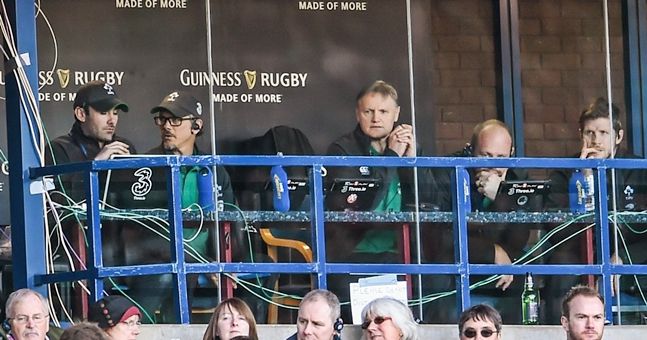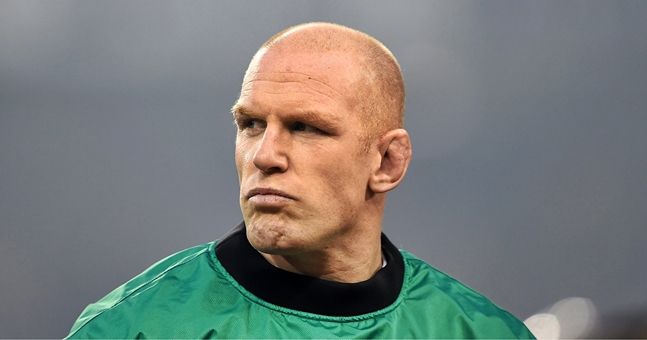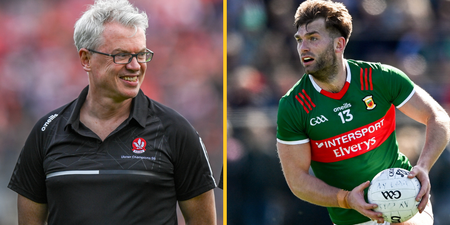“The first emails, they’re usually around six or a quarter to six.”
Not only does Joe Schmidt have a phenomenal work ethic, he demands the same of those around him. He demands the very best.
Those are the terms you sign up to as a player, coach or member of his backroom staff. Vinny Hammond was already in-situ as High Performance Analyst at the IRFU when Schmidt arrived but it did not take both men long to strike up a good working relationship.
Hammond was a decent rugby player with UCD but injuries did not help his cause and he found his way into professional rugby by developing into one of the top analysts in the game. Hammond joined The Hard Yards [from 12:00 below] to discuss his role and give a fascinating insight into what coaches and players may be looking for and that we rugby fans may be completely missing.
Hammond believes, in Simon Easterby, Greg Feek, Andy Farrell and Richie Murphy, Schmidt has assembled a fantastic coaching team but he notes that time with players, on an individual basis, is often quite restrained. That is why several of the coaches are frequent visitors around the provinces over the course of each season.
“If you look at an international week, for example, and work backwards – you have a match on a Saturday, team run on Friday, session on a Thursday, down day on Wednesday and either a Tuesday or a Monday session as you’re still recovering from the week before. So these guys only have the guts of two sessions to prepare for a Test match.”

Get to match day and Hammond is often sitting within touching distance of Schmidt in the coaches’ box. There will be a laptop, or two, open and he will be logging information. Sometimes confirming the opposition are playing the way they expected, other times trying to figure out what they are doing differently.
“Very often we’re just answering questions,” he says, “like, ‘Okay, can we go back and check out the set up of the last scrum’ or ‘Go back and look at the walk in to the last lineout’. It’s the tiny, tiny margins you’re trying to figure out and find, mid-game.”
There is no bigger example of these fine margins, to Hammond, than Jamie Heaslip’s 75th minute, last-ditch tackle against Scotland that ended up being crucial in Ireland winning the Six Nations. Had Heaslip given up on making that tackle – with Ireland already 40-10 ahead – his team would have been eventually pipped to the title on points difference when England beat France later that night.
As soon as each Ireland game finishes, Hammond and fellow analysts Jeff Blackburn and Mervyn Murphy will set to coding – taking a proper look back at the game, from the point of view of the team and individual players. Each player will get a video highlights package of their own contributions to the game.
A key element with feedback, says Hammond, is consistency. He comments:
“You can’t go judging them on one set of criteria one week and then, the next week, say, ‘You did this, this and this’ but you’re judging them off something else.
“If you’re a player, all you want is to be judged on the same yard-stick as you were the week before and as everybody else.”
The soak tackle
Hammond, who toured with the Lions this summer, has been working a lot with Ireland defence coach Andy Farrell since he came into the job part-way through 2016. It often takes a few months for coach and analyst to get into a pattern when it comes to looking at opponents and the performances of their own players.
“When Andy sees a soak tackle, for example,” Hammond explains, “we need to know what a soak tackle is in his eyes and not our eyes. It’s like tuning up to another coach and trying to align your thoughts to what he is thinking, and not necessarily what you think… they are the guys at the forefront, coaching, so you have to got with their thinking.”
[NOTE: Simply put, s soak tackle is when a tackler sets themselves to halt a ball-carrier and uses their forward momentum to drag them onto the ground]
Former Leinster and Ireland flanker Kevin McLaughlin, who was on the podcast, completely related to that point. He said:
“If the way you [the analyst] are classifying things is not a direct reflection of the way the coaches are talking about things in reviews and previews, then we have a big problem.”
McLaughlin recalls being distraught after some matches when he felt he had not played at his best, and he was quickly logging on to see what his match statistics were. He added:
“Lads can get pretty obsessed and upset if they feel they’ve been hard done by… They’d be sitting and looking at their stats, and going, ‘Vinny, that’s f**king bullshit. That’s not a soak!’.
“I remember in Leinster it used to happen all the time. There were certain times that guys would pull our analyst [Emmett Farrell] to one side, sit him down and go through every single stat, every single week and question every single one.”
“It’s always the same guys,” Hammond remarks.
“They’ll look over and go, ‘What’s this?!’ and when you tell them it’s a soak tackle, they will pull up someone else’s clips and say, ‘How come he didn’t get a soak tackle?!’ That’s the worst one. That means they’ve gone to the bother of looking at all the other soak tackles.”
One player that let nothing slip, when it came to giving feedback to his feedback, was Paul O’Connell.
“Paul was a nightmare,” says Hammond, “but in a great way. Lovely guy, lovely guy!”

McLaughlin and Hammond are in full agreement on an area that both O’Connell and Heaslip excelled at – big moments in games.
“Most top level coaches are good at that,” says Hammond. “They see the difference between a statistic and a performance. That’s really important. There are so many variables involved in any given game that to give a guy a cold number is counter-intuitive… Players just want to know can they perform in the really big moments in the game. That’s far superior than to maybe dropping two passes along the way.”














































